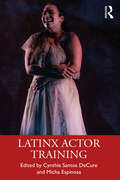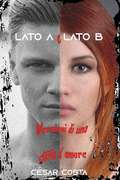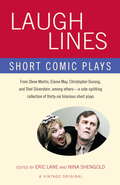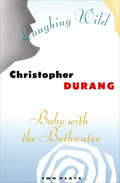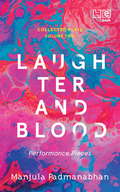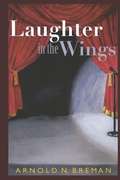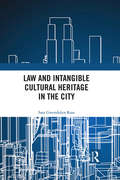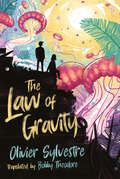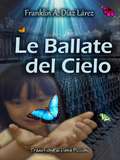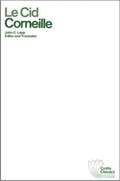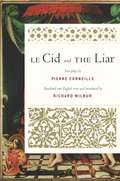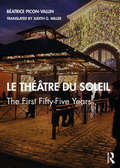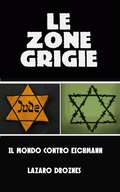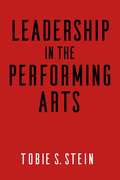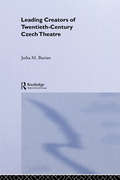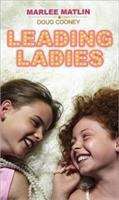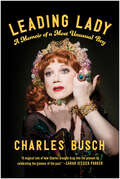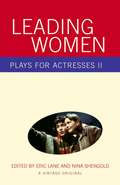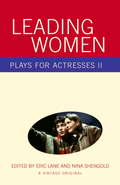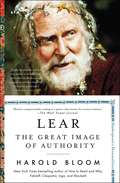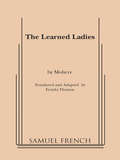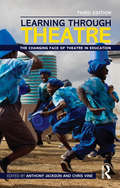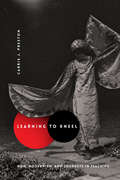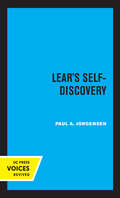- Table View
- List View
Latinx Actor Training
by Cynthia Santos DeCure Micha EspinosaLatinx Actor Training presents essays and pioneering research from leading Latinx practitioners and scholars in the United States to examine the history and future of Latino/a/x/e actor training practices and approaches. Born out of the urgent need to address the inequities in academia and the industry as Latinx representation on stage and screen remains disproportionately low despite population growth; this book seeks to reimagine and restructure the practice of actor training by inviting deep investigation into heritage and identity practices. Latinx Actor Training features contributions covering current and historical acting methodologies, principles, and training, explorations of linguistic identity, casting considerations, and culturally inclusive practices that aim to empower a new generation of Latinx actors and to assist the educators who are entrusted with their training. This book is dedicated to creating career success and championing positive narratives to combat pervasive and damaging stereotypes. Latinx Actor Training offers culturally inclusive pedagogies that will be invaluable for students, practitioners, and scholars interested in the intersections of Latinx herencia (heritage), identity, and actor training.
Lato A e Lato B: Versioni di una storia d’amore
by César CostaLato A e Lato B - Versioni di una storia d’amore Un romanzo pieno di colpi di scena, sorprese e drammi Roberto incontra l’amore della sua vita quando Jennifer si trasferisce nella stessa via in cui lui abita. Mentre vive incontri e scontri alla ricerca della sua passione adolescenziale, si sviluppa una bella e innocente storia d’amore, ricca di momenti emozionanti e dolorosi. Quando finalmente il destino sembra aiutare la coppia, scopriremo che esiste più di una versione, che spesso la realtà non è come sembra e che leggere i fatti da una nuova angolazione può cambiare tutta la prospettiva della storia.
Laugh Lines: Short Comic Plays
by Eric Lane Nina ShengoldThis one-of-a-kind anthology features thirty-six hilarious short plays by major American playwrights and emerging new voices, all guaranteed to send readers and audiences into peals of laughter. From the surrealistic wit of Steve Martin's "The Zig-Zag Woman" to the biting political satire of Steven Dietz's "The Spot," from Christopher Durang's wonderfully loopy "Wanda's Visit" to Shel Silverstein's supremely twisted "The Best Daddy," there's something in here to make everyone laugh. There are plays for casts of all sizes, from monologues to large ensembles, with diverse and challenging roles for actors of every age and type. Even the titles are funny: Mark O'Donnell's "There Shall Be No Bottom (a bad play for worse actors)," Elaine May's "The Way of All Fish," and Alan Ball's "Your Mother's Butt. " A bonanza for theatergoers, performers, and comedy fans,Laugh Lineswill bring down the house. From the Trade Paperback edition.
Laughing Wild and Baby with the Bathwater: Two Plays (Books That Changed the World)
by Christopher DurangA pair of plays from the comic genius who gave us the Tony Award-winning Vanya and Sonia and Masha and Spike.Baby and the Bathwater follows its main character from infancy to adulthood, in a confusing search for identity after an unusual upbringing. In Laughing Wild, two comic monologues evolve into a man and a woman’s shared nightmare of modern life and the isolation it creates. From her turf battles at the supermarket to the desperate clichés of self-affirmation he learns at his “personality workshop,” they run the gamut of everyday life’s small brutalizations until they meet, with disastrous inevitability, at the Harmonic Convergence in Central Park.The fiercely ironic dark comedy of Christopher Durang can be perfectly described by the quotation—by Thomas Gray via Samuel Beckett—that inspired one of these play’s titles: “Laughing wild amid severest woe.”“One of the funniest dramatists alive, and one of the most sharply satiric.”—The New Yorker
Laughter and Blood: Performance Pieces
by Manjula PadmanabhanConjoined triplets on a blind date. A lesson in human reproduction by a manic-prudish teacher. A heart-stopping game of cards. An instrument that tunes in to the music of our bodies’ organs.Collected Plays brings together, in a much-anticipated series, the dramatic works of Onassis prize-winning playwright and author Manjula Padmanabhan.Laughter and Blood, the second volume, presents within its covers Padmanabhan’s short performance pieces. From The Sextet and Ladies’ Night to Hidden Fires and Blind Date, these wildly inventive, subversive and often chilling plays introduce readers to the intrigues of inverted power structures, tantalizingly suggestive interactions and powerful voices from the fringe.With new introductions to the works that affirm the relevance of the themes of the plays, this collection showcases the playwright’s mastery of her art and reconfirms her standing among the leading dramatists of our time.
Laughter In The Wings
by Arnold BremanAfter nearly a half-century of directing American performing arts centers, impresario Arnold N. Breman has seen it all: eccentric songwriters, spotlight-craving comedians and insecure entertainers. In his memoir, Breman recalls encounters with some of the most beloved performers of our time, including: Ella Fitzgerald, Benny Goodman, Sarah Vaughan, Sammy Davis, Jr. , Cab Calloway, Isaac Stern, Itzhak Perlman, Beverly Sills, Marcel Marceau, Cary Grant, Lucille Ball, Gene Kelly, Gregory Hines, Linda Ronstadt, Red Skelton, Victor Borge and many others. This is the story of crowd-pleasers who left audiences dazzled and managers frantic, told with wit and candor of a presenter who kept laughing through it all.
Law and Intangible Cultural Heritage in the City
by Sara Gwendolyn RossWith disappearing music venues, and arts and culture communities at constant risk of displacement in our urban centers, the preservation of intangible cultural heritage is of growing concern to global cities. This book addresses the role and protection of intangible cultural heritage in the urban context. Using the methodology of Urban Legal Anthropology, the author provides an ethnographic account of the civic effort of Toronto to become a Music City from 2014-18 in the context of redevelopment and gentrification pressures. Through this, the book elucidates the problems cities like Toronto have in equitably protecting intangible cultural heritage and what can be done to address this. It also evaluates the engagement that Toronto and other cities have had with international legal frameworks intended to protect intangible cultural heritage, as well as potential counterhegemonic uses of hegemonic legal tools. Understanding urban intangible cultural heritage and the communities of people who produce it is of importance to a range of actors, from urban developers looking to formulate livable and sustainable neighbourhoods, to city leaders looking for ways in which their city can flourish, to scholars and individuals concerned with equitability and the right to the city. This book is the beginning of a conservation about what is important for us to protect in the city for future generations beyond built structures, and the role of intangible cultural heritage in the creation of full and happy lives. The book is of interest to legal and sociolegal readers, specifically those who study cities, cultural heritage law, and legal anthropology.
The Law of Gravity
by Olivier SylvestreDom has had a rough go of things so far. At fourteen, he has the hardened look of someone who’s had to fight for everything. Fred has just moved to Not-The-City, a new place to try to disappear. But he didn’t expect to actually make friends. He just hopes he’s accepted for how he looks. When Dom and Fred meet on a hill overlooking a bridge that connects Not-The-City to The City, a place where anyone can be anything they want, the two find a refuge in one another and make a pact: they’ll cross the bridge at the end of the school year. They’ll be free. What could happen by then? Who will they be? And will the bridge even let them cross?
Le Ballate del Cielo
by Franklin A. Díaz Lárez Elena PiccioniIn un Paese asiatico, una catena di strani accadimenti lascia la sua amara impronta di desolazione in centinaia di persone. Per decenni si contano dispersi, senza alcuna spiegazione. Un mistero insolito e insospettabile, riguardo al quale solo molti anni dopo iniziano ad apparire piste affidabili. Contemporaneamente, dalla parte opposta del pianeta, un giovane avvocato va incontro a un duro scontro con la realtà quando inizia a esercitare la propria professione in maniera indipendente. Colpito da ciò che vede, decide di rifugiarsi in un'altra attività legata alla sua formazione accademica, senza sospettare che, nel farlo, dovrà avventurarsi nei più intricati meandri delle sue paure, delle sue insicurezze e confrontarsi con i fantasmi del passato, che non lo hanno mai abbandonato. Per uno strano caso, le due storie si incroceranno e la conclusione sarà di forte impatto, un qualcosa che nessuno riesce a immaginare.
Le Cid (Crofts Classics #18)
by Pierre Corneille John C. LappEdited and translated by John C. Lapp, this edition of Le Cid for performance and study includes an introduction, which interprets the contemporary political, social, and romantic themes that give this tragedy its complex, interwoven structure. Also included are a selected bibliography and a list of the principal dates in the life of Corneille.
Le Cid and The Liar
by Pierre Corneille Richard WilburRichard Wilbur's translations of the great French dramas have been a boon to acting troupes, students of French literature and history, and theater lovers. He continues this wonderful work with two plays from Pierre Corneille: Le Cid is Corneille's most famous play, a tragedy set in Seville that illuminates the dangers of being bound by honor and the limits of romantic love; The Liar is a farce, set in France and dealing with love,misperceptions, and downright falsifications, which ends, of course, happily ever after. These two plays, together in one volume, work in perfect tandem to showcase the breadth of Corneille's abilities. Taking us back to the time he portrays as well as the time of his greatest success as a playwright, they remind us of that the delights to be found on the French stage are truly ageless.
Le Théâtre du Soleil: The First Fifty-Five Years
by Béatrice Picon-VallinLe Théâtre du Soleil traces the company’s history from a group of young, barely trained actors, directors, and designers struggling to match their political commitment to a creative strategy, to their grappling with the concerns of migration, separation and exile in the early decades of the twenty-first century. Béatrice Picon-Vallin recounts how, in the 55 years since its founding, the Théâtre du Soleil has established itself as one of the foremost names in modern theatre. Ariane Mnouchkine and her collaborators have developed a unique and ever-evolving style that combines a piercing richness of shape, color, and texture with precision choreography, innovative musical accompaniment, and multi-layered, metaphorical dreamscapes. This rich, storied history is illustrated by a wealth of spectacular rehearsal and production photos from the company's own archive and interviews with dozens of past and present members, including Mnouchkine herself. Judith G. Miller’s timely translation of the first comprehensive history and analysis of a remarkable, award-winning company is a compelling read for both students and teachers of Drama and Theatre Studies.
Le zone grigie: il mondo contro Eichmann
by Lázaro Droznes Stefano VazzolaIn questa libera ricostruzione del processo di Eichmann passiamo in rivista i temi che fanno la loro comparsa e continueranno a comparire fintanto che esisterà l'Umanità: la natura del nazionalsocialismo, la banalità del male esercitata dalla scrivania di un burocrate che uccide semplicemente trafficando con documenti e orari di treni, i limiti dell'obbedienza dovuta, la passività del popolo ebraico, la complicità della classe dirigente delle comunità ebraiche, l'indifferenza degli Alleati e della Chiesa di fronte alla mattanza e il retaggio che successivamente rese possibile la fondazione dello Stato ebraico. Il nazismo e l'olocausto ebraico sono un fatto storico che continuiamo a cercare di capire pur sapendo che non ci riusciremo mai. Com'è potuta succedere una cosa simile? Ci sarebbe stato uno Stato ebraico senza Hitler, senza il nazismo e senza l'Olocausto? È il prezzo che hanno dovuto pagare gli ebrei per avere un proprio Stato?
Leadership in the Performing Arts
by Tobie S. Stein Robert L. LynchWhat does it mean to be a performing arts leader? Leadership in the Performing Arts addresses and analyzes this question by presenting the wisdom and expertise of eleven men and women with experience leading nonprofit performing arts institutions in the United States. These successful leaders provide many real-world examples of business practices that may be generally applied by practitioners in our field, and throughout the nonprofit sector. The book examines: The leader’s career path and professional growthThe leader’s visionLeadership styles and the importance of interpersonal skillsSetting and executing organizational prioritiesLeading decision-making and communication processesCreating change and innovationChallenges faced in leading an institutionInterviewees include: Kathy Brown, executive director of the New York City Ballet; Peter Gelb, general manager of the Metropolitan Opera; Heather Hitchens, president of the American Theatre Wing; Karen Brooks Hopkins, president and chief executive officer of the Brooklyn Academy of Music; Timothy J. McClimon, president of the American Express Foundation; Laura Penn, executive director of the Stage Directors and Choreographers Society; Arlene Shuler, president and chief executive officer of New York City Center; Paul Tetreault, director of Ford's Theatre; Nancy Umanoff, executive director of the Mark Morris Dance Group; Patrick Willingham, executive director of The Public Theater; and Harold Wolpert, managing director of the Roundabout Theatre Company.Allworth Press, an imprint of Skyhorse Publishing, publishes a broad range of books on the visual and performing arts, with emphasis on the business of art. Our titles cover subjects such as graphic design, theater, branding, fine art, photography, interior design, writing, acting, film, how to start careers, business and legal forms, business practices, and more. While we don't aspire to publish a New York Times bestseller or a national bestseller, we are deeply committed to quality books that help creative professionals succeed and thrive. We often publish in areas overlooked by other publishers and welcome the author whose expertise can help our audience of readers.
Leading Creators of Twentieth-Century Czech Theatre (Routledge Harwood Polish And East European Theatre Archive Ser. #Vol. 7)
by Jarka M. BurianIn this invaluable and detailed presentation of the leading creative figures in a richly innovative and dynamic period of Czech theatre, Professor Jarka M. Burian provides us with insightful portraits of the directors K. H. Hilar, E. F. Burian, Alfred Radok, and Otomar Krejca: of the famous Voskovec and Werich comedic duo; of the scenographer Josef Svoboda; and of the playwright, now President of the Czech Republic, Václav Havel. There are also briefer studies of numerous other directors, designers, and actors. The author, a Czech-American theatre scholar and practitioner, has been a frequent on-site observer of Czech theatre since 1965. He is directly acquainted with many of the major artists and the most notable productions that have made Czech theatre internationally famous.
Leading Ladies
by Marlee Matlin Doug CooneyMegan's fourth-grade class is putting on their own original musical based on the book The Wizard of Oz, and Megan wants to be the star of the show and play Dorothy. Since she's deaf, she will sign the songs for her audition. However, a problem develops when Lizzie, her best friend from camp, transfers from her all-deaf school to Megan's class - and signs the same two songs that Megan was going to do! Luckily, Megan has some other ideas up her sleeve...
Leading Lady: A Memoir of a Most Unusual Boy
by Charles BuschA poignant, deliciously anecdotal account of a talented artist's Oz-like journey in the worlds of Off-Broadway, Broadway, and HollywoodThe Tony Award-nominated writer of The Tale of the Allergist&’s Wife and the long-running hit Off-Broadway play Vampire Lesbians of Sodom, and a Sundance Festival award winner, Charles Busch has created a unique place in the entertainment world as a playwright, LGBT icon, drag actor, director, and cabaret performer, with his extraordinary gift for both connecting with and channeling the leading ladies of show business. In wonderfully readable chapters, by turns comic and moving, Charles writes how ever since his mother's death when he was seven, he has sought out surrogate mothers in his life. In his teens, Charles moved to Park Avenue in Manhattan to live with his Auntie Mame-like Aunt Lil, who encouraged and nourished Charles&’ talents and dreams, and eventually he discovered his gifts for writing plays and performing as a male actress.Busch also shares his colorful and sometimes outlandish interactions with film and theatrical luminaries including the hilarious comedian Joan Rivers (who became a mother figure to Charles after Aunt Lil&’s death), Angela Lansbury (who attended her first Passover seder with Charles), Rosie O&’Donnell, Claudette Colbert, Valerie Harper, Kim Novak, and many others. Full of both humor and heart and featuring rare photos, Leading Lady is for readers of entertainment books as well as anyone who enjoys real-life stories of artists who break the mold, ditch the boundaries, and find their own unique way to sparkle.
Leading Women: Plays For Actresses II
by Eric Lane Nina ShengoldGather any group of actresses, from students to stars, and someone will inevitably ask, "Where are all the great roles for women?" The roles are right here, in this magnificently diverse collection of plays-full-lenghts, one-acts, and monologues--with mainly female casts, which represent the answer to any actress's prayer. The editors of the groundbreaking anthology Plays for Actresses have once again gathered an abundance of strong female roles in a selection of works by award-winning authors and cutting-edge newer voices, from Wendy Wasserstein and Christopher Durang to Claudia Shear, Eve Ensler, and Margaret Edson. The characters who populate these seven full-length plays, four ten-minute plays, and eleven monologues include a vivid cross-section of female experience: girl gang members, Southern debutantes, pilots, teachers, traffic reporters, and rebel teenagers. From a hilarious take on Medea to a taboo-breaking excerpt from The Vagina Monologues to a moving scene from the Pulitzer Prize-winning Wit, the plays in Leading Women are complex, funny, tragic, and always original--and a boon for talented actresses everywhere.
Leading Women
by Eric Lane Nina ShengoldGather any group of actresses, from students to stars, and someone will inevitably ask, "Where are all the great roles for women?" The roles are right here, in this magnificently diverse collection of plays–full-lenghts, one-acts, and monologues--with mainly female casts, which represent the answer to any actress's prayer. The editors of the groundbreaking anthologyPlays for Actresseshave once again gathered an abundance of strong female roles in a selection of works by award-winning authors and cutting-edge newer voices, from Wendy Wasserstein and Christopher Durang to Claudia Shear, Eve Ensler, and Margaret Edson. The characters who populate these seven full-length plays, four ten-minute plays, and eleven monologues include a vivid cross-section of female experience: girl gang members, Southern debutantes, pilots, teachers, traffic reporters, and rebel teenagers. From a hilarious take on Medea to a taboo-breaking excerpt fromThe Vagina Monologuesto a moving scene from the Pulitzer Prize-winningWit,the plays inLeading Womenare complex, funny, tragic, and always original--and a boon for talented actresses everywhere. From the Trade Paperback edition.
Lear: The Great Image of Authority (Shakespeare's Personalities #Vol. 39)
by Harold BloomHarold Bloom, regarded by some as the greatest Shakespeare scholar of our time, presents an intimate, wise, deeply compelling portrait of King Lear—the third in his series of five short books about the great playwright’s most significant personalities, hailed as Bloom’s “last love letter to the shaping spirit of his imagination” on the front page of The New York Times Book Review.King Lear is perhaps the most poignant character in literature. The aged, abused monarch—a man in his eighties, like Harold Bloom himself—is at once the consummate figure of authority and the classic example of the fall from majesty. He is widely agreed to be William Shakespeare’s most moving, tragic hero. Award-winning writer and beloved professor Harold Bloom writes about Lear with wisdom, joy, exuberance, and compassion. He also explores his own personal relationship to the character: Just as we encounter one Emma Bovary or Hamlet when we are seventeen and another when we are forty, Bloom writes about his shifting understanding—over the course of his own lifetime—of Lear, so that this book also explores an extraordinarily moving argument for literature as a path to and a measure of our humanity. Bloom is mesmerizing in the classroom, wrestling with the often tragic choices Shakespeare’s characters make. He delivers that kind of exhilarating intimacy, pathos, and clarity in Lear.
The Learned Ladies
by Freyda Thomas MoliereThis rollicking version of Les Femmes Savantes delighted audiences Off Broadway in a production starring Jean Stapleton as Philamente, a most unliterary lady intent on having a high toned literary salon. She has neither literary nor common sense, which makes her easy prey for sycophantic con artist Trissotin. He passes himself off as a famous poet and becomes a permanent house guest. Philamente hopes to marry her daughter to Trissotin, but the daughter wishes to marry the unsuitable Clitandre. This version strays from a strictly literal translation of Moliere's play, often employing anachronisms in the rhymed couplets that will appall purists and absolutely delight everyone else. If you want your audiences to roll with laughter as they watch a play by a "famous dead playwright," this version is for you.
Learning Through Theatre: The Changing Face of Theatre in Education
by Anthony Jackson Chris VineIn the two decades since the publication of the second edition, Learning Through Theatre has further established itself as an indispensable resource for scholars, practitioners and educators interested in the complex interrelations between teaching and learning, the performing arts, and society at large. Theatre in Education (TIE) has consistently been at the cutting edge of the ever-growing field of Applied Theatre; this comprehensively revised new edition makes an international case for why, and how, it will continue to shape ways in which the participatory arts contribute to the learning of young people (and increasingly, adults) in the 21st century. Drawing on the experiences and insights of theorists and practitioners from across the world, Learning Through Theatre shows how theatre can, and does, promote: participatory engagement; the use of innovative theatrical form; work with young people and adults in a range of educational settings; and social and personal change. Now transatlantically edited by Anthony Jackson and Chris Vine, Learning Through Theatre offers exhilarating new reflections on the book’s original aim: to define, describe and debate the salient features, and wider political context, of one of the most important – and radical – developments in contemporary theatre.
Learning to Kneel: Noh, Modernism, and Journeys in Teaching (Modernist Latitudes)
by Carrie J. PrestonIn this inventive mix of criticism, scholarship, and personal reflection, Carrie J. Preston explores the nature of cross-cultural teaching, learning, and performance. Throughout the twentieth century, Japanese noh was a major creative catalyst for American and European writers, dancers, and composers. The noh theater’s stylized choreography, poetic chant, spectacular costumes and masks, and engagement with history inspired Western artists as they reimagined new approaches to tradition and form. In Learning to Kneel, Preston locates noh’s important influence on such canonical figures as Pound, Yeats, Brecht, Britten, and Beckett. These writers learned about noh from an international cast of collaborators, and Preston traces the ways in which Japanese and Western artists influenced one another.Preston’s critical work was profoundly shaped by her own training in noh performance technique under a professional actor in Tokyo, who taught her to kneel, bow, chant, and submit to the teachings of a conservative tradition. This encounter challenged Preston’s assumptions about effective teaching, particularly her inclinations to emphasize Western ideas of innovation and subversion and to overlook the complex ranges of agency experienced by teachers and students. It also inspired new perspectives regarding the generative relationship between Western writers and Japanese performers. Pound, Yeats, Brecht, and others are often criticized for their orientalist tendencies and misappropriation of noh, but Preston’s analysis and her journey reflect a more nuanced understanding of cultural exchange.
Learning to Kneel: Noh, Modernism, and Journeys in Teaching (Modernist Latitudes)
by Carrie J. PrestonIn this inventive mix of criticism, scholarship, and personal reflection, Carrie J. Preston explores the nature of cross-cultural teaching, learning, and performance. Throughout the twentieth century, Japanese noh was a major creative catalyst for American and European writers, dancers, and composers. The noh theater's stylized choreography, poetic chant, spectacular costumes and masks, and engagement with history inspired Western artists as they reimagined new approaches to tradition and form. In Learning to Kneel, Preston locates noh's important influence on such canonical figures as Pound, Yeats, Brecht, Britten, and Beckett. These writers learned about noh from an international cast of collaborators, and Preston traces the ways in which Japanese and Western artists influenced one another. Preston's critical work was profoundly shaped by her own training in noh performance technique under a professional actor in Tokyo, who taught her to kneel, bow, chant, and submit to the teachings of a conservative tradition. This encounter challenged Preston's assumptions about effective teaching, particularly her inclinations to emphasize Western ideas of innovation and subversion and to overlook the complex ranges of agency experienced by teachers and students. It also inspired new perspectives regarding the generative relationship between Western writers and Japanese performers. Pound, Yeats, Brecht, and others are often criticized for their orientalist tendencies and misappropriation of noh, but Preston's analysis and her journey reflect a more nuanced understanding of cultural exchange.
Lear's Self-Discovery
by Paul A. JorgensenThis title is part of UC Press's Voices Revived program, which commemorates University of California Press’s mission to seek out and cultivate the brightest minds and give them voice, reach, and impact. Drawing on a backlist dating to 1893, Voices Revived makes high-quality, peer-reviewed scholarship accessible once again using print-on-demand technology. This title was originally published in 1967.
